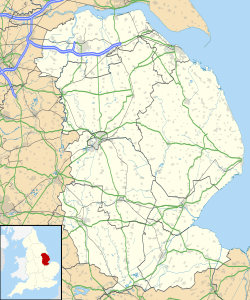Broadholme Priory facts for kids
| Monastery information | |
|---|---|
| Other names | The Convent of St. Mary's, Broadholme, |
| Order | Premonstratensian |
| Established | Before 1154 |
| Disestablished | 1536 |
| Mother house | Newsham Abbey |
| Dedicated to | God and St. Mary |
| Site | |
| Location | Lincolnshire, England Before 1989: Nottinghamshire |
| Coordinates | 53°15′05″N 0°39′39″W / 53.2514°N 0.6609°W |
| Grid reference | SK 8950 7353 |
| Visible remains | None Visible. Elements of the monastic buildings thought to have been incorporated into Manor Farm. |
Broadholme Priory was a special religious house. It was home to a group of women called Premonstratensian canonesses. These women were like nuns who followed a specific religious rule. The priory was located near the village of Broadholme. For a long time, it was in Nottinghamshire. But after some boundary changes in 1989, it is now part of Lincolnshire.
Contents
History of Broadholme Priory
This priory was started a very long time ago, even before the year 1154. It was one of only two places in England for Premonstratensian women. When it first began, both men (canons) and women (canonesses) lived there.
The priory was dedicated to God and Saint Mary. Its main monastery, called its "mother-house," was Newsham Abbey in Lincolnshire.
Income and Support
In the late 1200s, a record called Pope Nicholas IV's taxation roll showed the priory's income. It earned about £4 and 13 shillings each year. This was a record of how much money religious places made for tax purposes. The priory also controlled a church in Thorney, Nottinghamshire. This church brought in an extra £8 every year.
King Edward II gave the priory a special document in 1318. This document was called a "charter of confirmation." It officially approved the priory's rights and gifts. The charter also listed many people who had given gifts to the priory. These gifts were called "benefactions."
Some of the people who helped the priory included:
- Ralph D'Aubeney, who gave an orchard.
- Hugh de Basset, who gave money and corn.
- Walter and Agnes de Clifford, who gave a church, land, and a mill.
- Peter and Agnes Goushill, who gave land and buildings in Saxilby.
- William Newbrid, who gave money in Broadholme.
Royal Patronage
Queen Isabel, who was King Edward II's wife, really liked the canonesses. She was a "patroness," meaning she supported them. In 1327, she promised to give the priory 8 marks every year. This money came from her lands in Great Massingham. In 1329, the Sheriff of Norfolk was told to make sure the priory received its payments.
In October 1327, Queen Isabel also helped the priory get more land. This land was worth £10 per year. This was done through a process called Mortmain, which allowed religious groups to own land permanently.
Life at the Priory
In 1478, someone visited the priory and wrote down what they saw. It was noted that all the canonesses could read and sing. This shows they were educated.
By 1494, the priory was home to the prioress (the leader) and eight other canonesses. The prioress at that time was Dame Elizabeth Brerworth.
Dissolution and Remains
In 1534, another record called the Valor Ecclesiasticus was made. It showed that the priory's total annual value was £18, 11 shillings, and 10 pence.
The priory was closed down in 1536. This was part of a big event called the Dissolution of the monasteries. During this time, King Henry VIII closed many monasteries in England. On December 12, 1536, the last prioress, Joan Aungewen, was given a pension. A pension is like a regular payment given to someone after they stop working. Her pension was 7 marks.
In 1537, the land where the priory stood was given to a man named Ralph Jackson by the King.
What's Left Today
Today, you can't see any clear remains of the old priory buildings. It is believed that parts of the old monastery were used to build Manor Farm. This farm was built right on the same spot. The priory's chapel was likely at the back of the current house. The cemetery was to the east, where an orchard is now. The priory also had fishponds, but these were filled in during the 1960s.
Prioresses of Broadholme
- Matilda, recorded in 1326
- Joan de Rield, recorded in 1354
- Agnes de Belyngham, recorded in 1418
- Elizabeth de Brerworth, recorded in 1496
- Joan Aungewen, recorded in 1534 and 1536


